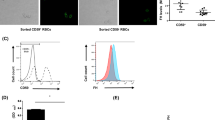Summary
The efficiency of cytolysis by the terminal complement proteins C5b-9 can be markedly enhanced by C3b molecules bound on the target cell membrane (Hammer et al. 1976). This enhancement was shown to be proportional to the number of C3b molecules on the cell membrane. The present experiments have shown that the hemolytic efficiency of the complement membrane attack system is two to five times greater on paroxysmal nocturnal hemoglobulinuria erythrocytes (PNHE) than on normal human E. This difference is attribut to a derivative of C3, probably C3b, on PNHE since it was abolished by anti-C3 but not by anti-C2. The efficiency of C5b-9 to lyse PNHE was only partially decreased by C3b inactivator and β 1H, indicating that the C3b on PNHE is not readily inactivated by its regulatory proteins. Furthermore, cells from a single severely affected patient consumed 3-fold more C5b6 than normal human E yet concommitantly measured membrane fluidity was normal. From these observations we conclude that cell-bound C3b on PNHE serves two functions: (a) it increases the hemolytic efficiency of membrane attack components of the complement system; and (b) it provides sites for assembly of the alternative pathway convertases.
Similar content being viewed by others
References
Bell WR (1978) Paroxysmal nocturnal hemoglobinuria: Clinical conferences at the Johns Hopkins Hospital. Johns Hopkins Med J 142: 218–223
Borochou H, Zahler P, Wilbrandt W, Shinitzy M (1977) The effect of phosphatidylcholine to sphingomyelin mole ratio on the dynamic properties of sheep erythrocyte membrane. Biochim Biophys Acta 470: 382–388
Borsos T, Rapp HJ (1969) Immune hemolysis: A simplified method for the preparation of EAC14 with guinea pig or human complement. J Immunol 99: 263–268
Charache S (1969) Prolonged survival in paroxysmal nocturnal hemoglobinuria. Blood 33: 877–883
Dalmasso AP, Pizzimenti MC, Vacs E, Diaz A (1974) Abnormal solubilization by Triton X-100 of erythrocyte membranes from patients with paroxysmal nocturnal hemoglobinuria. Proc Soc Exp Biol Med 174: 273–279
De Gier J, van Deenen LLM, Verloop MC, van Gastel C (1964) Phospholipid and fatty acid characteristics of erythrocytes in some cases of anaemia. Br J Haematol 10: 246–256
Fearon DT, Austen KF (1978) Activation of the alternative complement pathway due to resistance of zymosan-bound amplification convertase to endogenous regulatory mechanisms. Proc Nat Acad Sci USA 74: 1683–1687
Fearon DT, Austen KF (1977) Activation of the alternative complement pathway with rabbit erythrocytes by circumvention of the regulatory action of endogenous control proteins. J Exp Med 146: 22–33
Fearon DT, Austen KF, Ruddy S (1973) Formation of a hemolytically active cellular intermediate by the interaction between properdin factors B and D and the activated third component of complement. J Exp Med 138: 1305–1313
Goetze O, Müller-Eberhard HJ (1970) Lysis of erythrocytes by complement in the absence of antibody. J Exp Med 132: 898–915
Hammer CH, Abramovitz AS, Mayer MM (1976) A new activity of complement component C3: Cell-bound C3b potentiates lysis of erythrocytes by C5b6 and terminal components. J Immunol 117: 830–834
Hunsicker LG, Ruddy S, Austen KF (1973) Alternate complement pathway: factors involved in cobra venom factor (CoVF) activation of the third component of complement (C3). J Immunol 110: 128–138
Kabat EA, Mayer MM (1961) Experimental Immunochemistry, 2nd edn. Charles C Thomas, Springfield, IL
Kato K, Bito Y (1978) Relationship between bactericidal action of complement and fluidity of cellular membranes. Infect Immun 19: 12–17
Law SK, Levine RP (1977) Interaction between the third complement protein and cell surface macromolecules. Proc Nat Acad Sci USA 74: 2701–2705
Leibetseder F, Ahrens EH (1959) The fatty acid composition of red cells in paroxysmal nocturnal hemoglobinuria. Br J Haematol 5: 356–364
Logue GL, Rosse WF, Adams JP (1973) Mechanisms of immune lysis of red blood cells in vitro. I. Paroxysmal nocturnal hemoglobinuria cells. J Clin Invest 52: 1129–1137
May JE, Rosse W, Frank MM (1973) Paroxysmal nocturnal hemoglobinuria alternate-complement pathway-mediated lysis induced by magnesium. N Engl J Med 289: 705–709
Mayer MM, Miller JA (1965) Inhibition of guinea pig C2 by rabbit antibody. Immunochemistry 2: 71–93
Mayer MM, Miller JA, Shin HS (1970) A specific method for purification of the second component of guinea pig complement and a chemical evaluation of the one-hit theory. J Immunol 105: 327–341
Mengel CF, Kann HE, Meriwether WD (1967) Studies of paroxysmal nocturnal hemoglobinuria erythrocytes: Increased lysis and lipid peroxide formation by hydrogen peroxide. J Clin Invest 46: 1715–1723
Munn JI, Crosby WH (1957) Paroxysmal nocturnal haemoglobinuria. Evidence of defect of red cell stroma manifested by abnormalities of lipids. Proc Soc Exp Biol Med 96: 480–482
Nelson RA, Jensen J, Gigli I et al. (1966) Methods for the separation, purification and measurement of nine components of hemolytic complement in guinea pig serum. Immunochemistry 3: 111–135
Nicholson A, Brade V, Lee GD, Shin HS, Mayer MM (1974) Kinetic studies of the properdin system enzymes on zymosan: Evidence that nascent C3b controls the rate of assembly. J Immunol 112: 1115–1123
Platt-Mills TAE, Ishizaka K (1974) Activation of the alternative pathway of human complement by rabbit E. J Immunol 113: 348–357
Rounault TA, Rosse WF, Bell S, Shelburne J (1978) Differences in the terminal steps of complement lysis of normal and paroxysmal nocturnal hemoglobinuria red cells. Blood 51: 325–330
Shinitzky M, Barenholz Y (1974) Dynamics of the hydrocarbon layer in liposomes of lecithin and sphingomyelin containing dicetylphosphate. J Biol Chem 249: 2652–2657
Yamamoto K, Gewurz H (1978) The complex of C5b and C6: Isolation, characterization, and identification of a modified form of C5b consisting of three polypeptide chains. J Immunol 120: 2008–2015
Author information
Authors and Affiliations
Rights and permissions
About this article
Cite this article
Jones, C.M., Shin, M.L. & Mayer, M.M. On the lysis of paroxysmal nocturnal hemoglobinuria erythrocytes by complement: Dual role of C3b. Blut 45, 249–259 (1982). https://doi.org/10.1007/BF00320192
Received:
Accepted:
Issue Date:
DOI: https://doi.org/10.1007/BF00320192




